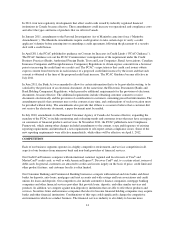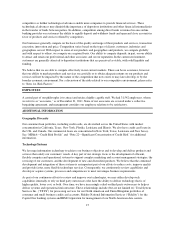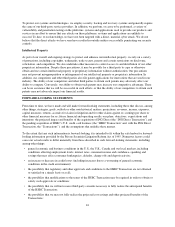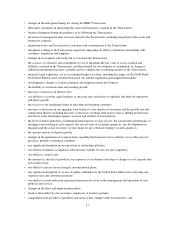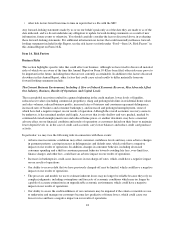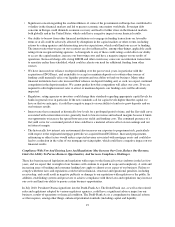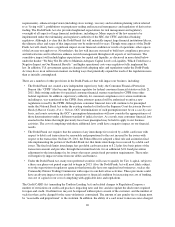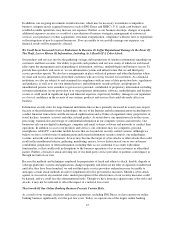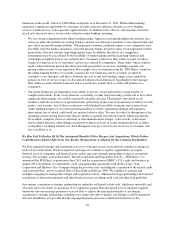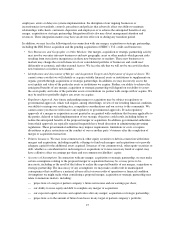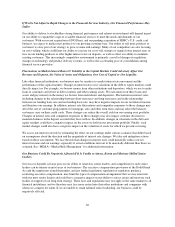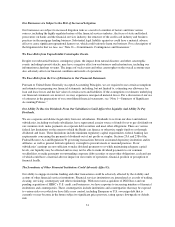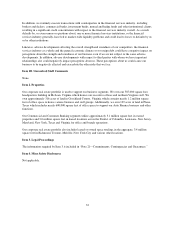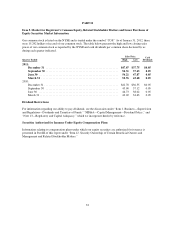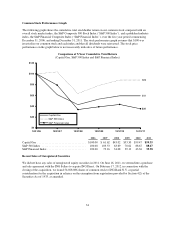Capital One 2011 Annual Report Download - page 44
Download and view the complete annual report
Please find page 44 of the 2011 Capital One annual report below. You can navigate through the pages in the report by either clicking on the pages listed below, or by using the keyword search tool below to find specific information within the annual report.completing a written implementation plan and building processes and systems to comply with the rules.
Compliance with the Basel II rules will require a material investment of resources. In addition, our current
analysis suggests that our risk-weighted assets will increase under the Basel II framework, and therefore we
would need to hold more regulatory capital in order to maintain a given capital ratio.
See “Item 1. Business—Supervision and Regulation” for additional information.
We Face Risk Related To Our Operational, Technological And Organizational Infrastructure.
Our ability to grow and compete is dependent on our ability to build or acquire necessary operational,
technological and organizational infrastructure. We are in the process of completing significant development
projects to complete the systems integration of prior acquisitions and to build a scalable infrastructure in both our
Retail Banking and Commercial Banking businesses. We anticipate making additional infrastructure changes and
upgrades in connection with the integration of ING Direct and the pending acquisition of HSBC’s U.S. credit
card business. Our pending acquisition of the HSBC U.S. credit card business in particular involves the transfer
of intellectual property, servicing platforms, infrastructure, contact centers and a significant number of
employees. We expect that decoupling and transitioning these assets, infrastructure and systems from HSBC’s
current systems and operations and integrating them into our own business operations will be a highly complex
process. These infrastructure changes, upgrades and integrations may cause disruptions to our existing and
acquired businesses, including, but not limited to, systems interruptions, transaction processing errors,
interruptions to collection processes and system conversion delays, all of which could have a negative impact on
us. In addition, we expect to enter into numerous transitional service arrangements with HSBC entities that will
provide for services associated with the decoupling and transition of the business. Under these arrangements,
HSBC will provide certain services to us and we will provide certain services to HSBC. These transitional
service arrangements will continue for various dates until the separation of the business from HSBC is complete,
and during that time we will rely on the ability of the applicable HSBC entities to provide these services. The
complexities and requirements of these arrangements will increase the operational risk associated with the
transition and integration of the business, and this increased risk could lead to unanticipated expenses,
disruptions to our operations or other adverse consequences.
While we expect the pending acquisition of HSBC’s U.S. credit card business will close in the second quarter of
2012, the complexities of the decoupling and transition could present risks of delay to our anticipated closing
timing. Any significant delay in closing the acquisition could have a negative impact on our results of operations
due to increased costs or a delay in our realization of the anticipated benefits of the acquisition.
Similar to other large corporations, we are exposed to operational risk that can manifest itself in many ways, such
as errors related to failed or inadequate processes, faulty or disabled computer systems, fraud by employees or
persons outside of our company and exposure to external events. In addition, we are heavily dependent on the
strength and capability of our technology systems which we use to manage our internal financial and other
systems, interface with our customers and develop and implement effective marketing campaigns. Our ability to
develop and deliver new products that meet the needs of our existing customers and attract new ones and to run
our business in compliance with applicable laws and regulations depends on the functionality and reliability of
our operational and technology systems. Any disruptions or failures of our operational and technology systems,
including those associated with improvements or modifications to such systems, could cause us to be unable to
market and manage our products and services or to report our financial results in a timely and accurate manner,
all of which could have a negative impact on our results of operations.
In some cases, we and the businesses we are acquiring outsource the maintenance and development of
operational and technological functionality to third parties. These third parties may experience errors or
disruptions that could adversely impact us and over which we may have limited control. Any increase in the
amount of our infrastructure that we outsource to third parties may increase our exposure to these risks.
24


